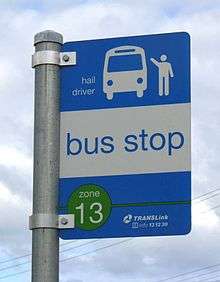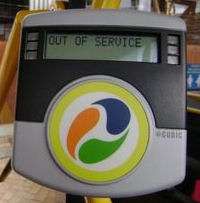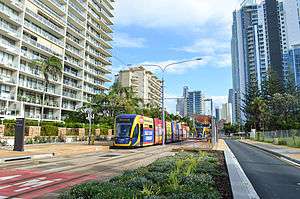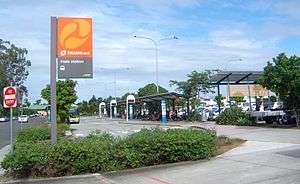TransLink (South East Queensland)
 | |
| Formation |
TransInfo August 1993 TransLink division of Queensland Transport June 2003 TransLink Transit Authority July 2008 Translink division of Queensland Department of Transport and Main Roads November 2012 |
|---|---|
| Type | Departmental agency |
| Purpose | Coordinate and integrate public transport services |
| Headquarters | Brisbane |
| Location | |
Membership |
Brisbane Transport Brisbane Ferries Queensland Rail Keolis Downer (Gold Coast Light Rail) Other bus operators |
Director-General | Neil Scales |
| Website | www.translink.com.au |
TransLink is an agency of the Department of Transport and Main Roads first introduced by the Queensland Government in June 2003 to coordinate and integrate bus, ferry and rail services. TransLink works with Airtrain Citylink, Brisbane Transport, Transdev Brisbane Ferries, Queensland Rail and 17 other operators to provide these services in South East Queensland. TransLink operates an integrated ticketing system and the go card smartcard system to allow the use of one ticket on multiple services.
In July 2008 TransLink devolved from being a division of Queensland Transport to the more autonomous TransLink Transit Authority. In November 2012 the Authority was dissolved and reabsorbed as a division of the Queensland Department of Transport and Main Roads.[1] Combining the former Authority and qConnect, it is now responsible for the co-ordination of public transport across the whole of Queensland.
History
TransInfo was a phone inquiry and timetable service established in August 1993 by Queensland Transport. It was found to be a very successful service, and in a 1997 research study 99% of surveyed transport users were either very or fairly satisfied with the service.[2] After the success of TransInfo, in June 2003 the Queensland Government introduced TransLink as an agency within Queensland Transport, replacing the former TransInfo service. With a $21.4 million budget, TransLink was tasked to introduce common fares, zones and ticket types irrespective of transit mode, and from mid-2004 a smartcard system. Prior to TransLink's introduction, combined patronage for public transport services was only around 112 million trips per year.[3][4]
TransLink delivered the new integrated ticketing system in July 2004. To help facilitate the change-over, TransLink employed and deployed throughout South East Queensland 100 assistants. A daily ticket was introduced which allowed unlimited travel on all modes of public transport within the zones specified on the ticket, and for the first time students and aged pensioners throughout South East Queensland received a 50% discount on fares.[5] In just two months an extra 2.3 million passengers travelled on transit services, and ticket sales increased by 11%.[5] Following TransLink's introduction, transit passenger numbers grew faster than ever before. In 2005, TransLink saw close to a 20% increase in passenger numbers.[6][7]
In February 2008, the go card was rolled out on bus, rail and ferry services in Brisbane only, as a precursor to its introduction throughout South East Queensland.[8] The Queensland Government devolved TransLink from being a division of Queensland Transport to the more autonomous TransLink Transit Authority in July 2008, increasing its profile with new branding. At the same time a 24-hours-a-day, seven-days-a-week customer information and support phone number was introduced.[9][10]
In November 2009, TransLink introduced cashless tickets during peak times, only accepting only go cards and pre-purchased paper tickets in an effort to improve service efficiency. In late 2009, TransLink scrapped monthly and weekly paper tickets, with plans to eliminate paper tickets by the end of 2010.[11][12] On 4 January 2010, to encourage the use of the go card, off-peak discounts and a direct debit top-up option were introduced. At the same time, TransLink increased fares and also announced fares would increase by a further 45% over the following three years.[11]
Ticketing


TransLink uses zones to determine fares no matter which transit mode or route a passenger uses. In South East Queensland the zones are rings centred on the Brisbane CBD. The zone network stretches from Gympie (170 km north of Brisbane) to Coolangatta (100 km south of Brisbane), and from Helidon (80 km west of Brisbane) in the west to Moreton Bayside suburbs of Brisbane and Redland in the east.
Originally there were 23 zones. On 19 December 2016, the number of zones was reduced to eight. At the same time, a new fare structure was introduced that included:
- Cheaper fares across all zones
- Off-peak discounts extended to 6am (from 3am)
- Free travel for seniors after 2 journeys each day and Concession Pensioner Card holders
- Free weekend travel on a child go card
- Half-price journeys after 8 in a week
There are 11 zones in Cairns and 15 zones in Mackay.
go card
TransLink offers a contactless fare payment card called go card. It requires passengers to touch the card on a card reader at the start and end of each journey, and when transferring between services. The fare is automatically calculated based on the difference between the highest zone number and the lowest zone number recorded for the journey. A journey can comprise any number of individual legs (each recorded by touching the card when entering or leaving a service) within a two-hour period. The fare is automatically deducted from a pre-paid balance associated with the go card used.
The following types of go card are available:
- Adult go card is for use by passengers without concessions. Tertiary students, job seekers and asylum seekers will need to have an adult go card to have concession fares activated on the card.
- Child go card is for use by children under the age of 15 years.
- Concession go card is for use by passengers entitled to a concession, such as secondary students, holders of a Pensioner Concession Card, and holders of a Repatriation Health Card.
- Seniors go card is for use by passengers who have a Queensland Seniors Card issued by the Queensland Government.
- Seniors+go card incorporates a Queensland Seniors Card and a go card on both sides.
SEEQ card
The SEEQ card was introduced in late 2012 for visitors to South East Queensland. This card provides for travel for a period of 3 or 5 days across TransLink the network. The card can also be used to receive discounts at retail locations throughout the South East Queensland region.[13]
Paper tickets
A single-fare paper ticket is also available for infrequent travellers and visitors.[14]
- Single – one-way travel with unlimited transfers for two hours for travel through up to 10 zones and three-and-a- half hours for more than 10 zones.
- Single (Concession) – for eligible students, pensioners and children, who travel for half the price of an equivalent regular adult fare. Children under five years of age travel free. A valid concession card must be presented when purchasing and presenting a concession ticket.[15]
Authorised Officers
TransLink employ a team of authorised officers called Senior Network Officers. Senior Network Officers were introduced in 2010 and they utilise powers available under section 111(3) of the Transport Operations (Passenger Transport) Act 1994 and Transport Infrastructure Act 1994.
As authorised officers, they enforce TransLink's conditions of travel for passengers on the network. Senior Network Officers issue infringement notices for transport offences.
Senior Network Officers also carry handcuffs and can exercise a power to detain for certain offences committed on public transport[16]
Regions

The TransLink network is divided into eleven different regions for bus services, each region operated by a different bus operator. The regions are based largely on local government boundaries.[17] In October 2007, a common white, green, blue and orange TransLink livery was introduced to the fleets of all South East Queensland operators.[18]
Greater Brisbane
Northern
Southern
Eastern
Western
- Bus Queensland Ipswich
- Bus Queensland Lockyer Valley
- Southern Cross Transit
Sunshine Coast
Gold Coast

Mackay
Other qconnect regions
- Airlie Beach and Proserpine
- Bowen
- Bundaberg
- Gladstone
- Gympie
- Hervey Bay
- Innisfail
- Kilcoy to Caboolture
- Magnetic Island
- Maryborough
- North Stradbroke Island
- Rockhampton
- Sunshine Coast Hinterland
- Toowoomba
- Townsville
- Warwick
Infrastructure
References
- ↑ Qld Parliament approves dissolving Translink ABC News 2 November 2012
- ↑ Johnson, Vaughan (21 November 1997). "TransInfo demand surging". Ministerial Media Statements. Queensland Government.
- ↑ Bredhauer, Stephen (5 June 2003). "New agency to introduce integrated ticketing". Ministerial Media Statements. Queensland Government.
- ↑ Lucas, Paul (23 April 2004). "Information on how to get 'one ticket please' to SEQ". Ministerial Media Statements. Queensland Government.
- 1 2 Beattie, Peter (1 July 2004). "TransLink integrates "three Rs" of public transport". Ministerial Media Statements. Queensland Government.
- ↑ Lucas, Paul (15 July 2005). "Happy birthday TransLink". Ministerial Media Statements. Queensland Government.
- ↑ Lucas, Paul (5 July 2005). "TransLink second birthday celebrations mark milestone with muffins". Ministerial Media Statements. Queensland Government.
- ↑ Mickel, John (14 July 2006). "1,000 volunteers to test new smart card". Ministerial Media Statements. Queensland Government.
- 1 2 "Fare Restructure". Archived from the original on 17 April 2010. Retrieved 23 March 2010.
- ↑ Marissa Calligeros (30 September 2009). "Cash free zones: buses to go card-only". Brisbane Times. Fairfax Digital.
- ↑ "SEEQ Card". Retrieved 12 May 2013.
- ↑ "TransLink Paper Tickets". Retrieved 15 June 2011.
- ↑ "TransLink Concessions". Retrieved 23 March 2010.
- ↑ "Senior Network Officer Powers". Retrieved 12 February 2018.
- ↑ "TransLink regions and service area". Retrieved 23 March 2010.
- ↑ New Look, New Buses for Sunny Coast Minister for Transport, Trade, Employment & Industrial Relations 6 October 2007
External links
![]()
